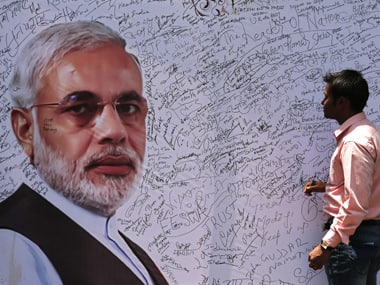The spectacular victory of the Modi-led BJP – which could well give the party a majority of its own as per mid-day trends – has shown how wrong our intellectuals and media commentators have been. They substituted wishful thinking for analysis, and managed to miss what was visible to everyone. They failed to see a wave welling up in their midst. The history of this election is a history of our intellectuals being willfully blind to what was in front of them. [caption id=“attachment_1527465” align=“alignleft” width=“380”]  Modi’s Representational Image. Reuters[/caption] First, they said, there are serious dissenters in the BJP and so Modi’s road to the prime ministership won’t be easy. They forgot that Modi’s elevation was driven by the party’s grassroots and not by leaders in Delhi without a base. So fossils like LK Advani and Jaswant Singh were seen as some kind of huge barrier to Modi. They failed to see the power-shift underway in the party. The party’s grassroots ensured that not only its leaders fell in line, but even the RSS could not ultimately stop Modi from being elevated to prime ministerial candidate. Second, they said even if Modi gets the party’s nomination, he won’t get allies. For Modi is a polarising figure. Team Modi went about stitching allies one by one, in UP, Bihar, Maharashtra, Tamil Nadu and, finally, Andhra Pradesh. Now, with victory in sight, it won’t lack for any ally. Third, they said that Muslims and the minorities would stem the BJP tide. Towards the final stages, it was believed that the Samajwadi Party in Uttar Pradesh and the RJD-Congress alliance in Bihar would do much better than expected. They turned out to be paper tigers. Fourth, they said that the regional parties would prevent a Modi sweep. The big numbers posted by the AIADMK, the BJD and the Trinamool Congress would seem to suggest that this could well be the case. But the reality could be more complex: the superb results of these parties could also be because of the BJP’s surge. As the BJP vote share surged, it took away a lot of the anti-incumbency votes of the AIADMKs, TMCs and BJDs. This may be why they did even better than before. Fifth, they said that caste and other factors would stymie the BJP in various parts of the country. Modi has swept many caste issues away with his focus on the big message. Mayawati got nowhere in UP. Sixth, they said a US-style presidential campaign was irrelevant in diverse India. Some even said that India is a parliamentary democracy, and announcing a PM candidate would make no difference to the outcome. But the outcome clearly shows that India has changed, and Modi has captured the imagination of the country. Seventh, they trotted out last election’s statistics to show that whatever Modi does, the numbers do not add up – especially in UP. Modi has always maintained that elections are as much about chemistry as caste arithmetic. He turned out to be right. Number-watchers should know that while numbers may be relevant, they should know when mood can triumph numbers. Eighth, they said that you have to be a self-effacing compromiser to lead diverse India. Being a consensus-builder is a good thing in general; but sometimes consensus-building only ends up with sub-optimal solutions and messy compromises. Modi has shown that sometimes one has to stand for something to achieve something. The doormat approach of Manmohan Singh brought the whole idea of a self-effacing leader into disrepute. Ninth, they said Modi’s campaign was more hype that reality. Well, if that was the case, the people of India would not have given him the BJP its biggest mandate in history. Tenth, they said the exit polls would be wrong. They were right. But exit polls have usually got the broad trends right, but not the final extent of the trend. This poll shows the pollsters in good light. They got the NDA victory right; they just could not foresee that the trend will take the BJP all the way to 272. Or thereabouts.
Everything that our commentators and intellectuals said about Modi has turned out to be wrong.
Advertisement
End of Article
Written by R Jagannathan
R Jagannathan is the Editor-in-Chief of Firstpost. see more


)
)
)
)
)
)
)
)
)



